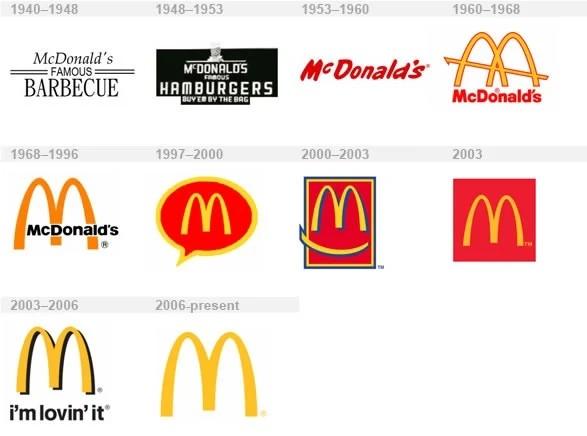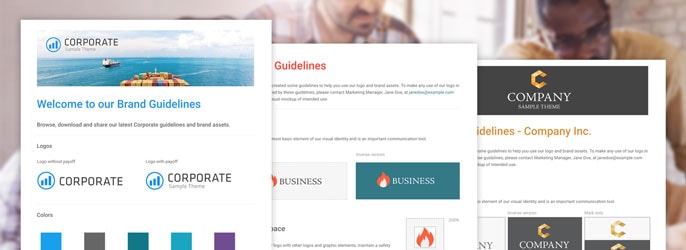Logo Redesign
Your Complete Guide to a Logo Redesign
The logo is a vital branding asset that symbolizes your brand. Many of the big brands you know today aren't using the same logos they had when they started. Their logos have gone through different changes to address the shifts in their branding and keep up with time.
The same should apply to your business. You have to redesign your logo more than once to reflect your brand's values and purpose more accurately. However, you may meet some resistance from your customers as they may have already gotten used to your former logo. But as long as your new logo is carefully designed to preserve your brand's purpose and integrity.
This article will share a seven-step guide to redesigning a logo.
1. Identify the reason behind the redesign
First off, when redesigning a logo, you have to identify the why behind the redesign. Redesigning a logo for no reason may negatively affect how people perceive your brand.
Being intentional about your logo gives your audience an impression that you are a professional, which builds trust. A well-polished logo makes people want to see more of your brand.
Below are solid reasons behind a logo redesign:
Great for marketing: A new logo announcement is an excellent opportunity to reintroduce your brand to the world, especially if you’re pivoting towards a new business model or shifting your leadership style. You can spread the word about your new logo by showcasing it on your website, then creating quality guest posts that link back to it.
Expression of your current brand: Your business will keep progressing. Therefore, your business requirements will also change. Because those changes might affect your core business, updating your logo will allow your branding to keep in step with what your business does.
You can also do a logo redesign when your business expands, experiences a boost in brand awareness, or release new products.
When should you make the change?
Some companies may have a gradual logo redesign process, while others may do theirs rapidly within a short time frame. Over time it is also possible that you now appeal to a new set of target audiences or your audience's behavioral pattern may change.
McDonald’s is a classic example of a company that changed its logo to adapt to its customer base. Starting as a barbecue restaurant, the company shifted to burgers, then removed “hamburgers” from its logo to reflect its expanded menu. From 1960 to the present, its logo has featured its iconic “Golden Arches” trademark, with minor changes to adapt to market trends.
The logo’s current form no longer features the company name or even a slogan, but it has been in use since 2006. Barring any significant market changes, it might stay for decades to come.

However, the company didn’t come up with its current logo on a whim. It performed customer analysis to discover its core customer base and its preferences. Using the insights gathered from the study, McDonald’s determined that the Golden Arches trademark is now synonymous with the brand and is recognizable everywhere.
2. Do a brand audit
A brand audit covers internal branding, external branding, and customer experience. We will be discussing a brand audit that concerns external branding in this article.
A brand audit evaluates your current brand's positioning, which can direct your logo redesign process. Performing a brand audit when redesigning your logo allows you to identify what to keep in the logo and what elements to remove. It also stops you from committing common marketing mistakes that can divert your brand’s positioning in the audience's mind.
By performing a brand audit, you will also become aware of opportunities in the marketplace that you can capitalize on to build a strong brand.

The first step is to analyze your logo and see how it can be redesigned.
Go through your external branding materials. Is the logo, for example, consistent with your online appearance? You should confirm if anything has changed with your company's tone, color, style, and designs to build your website or create marketing collateral like letterheads, email signatures, or social media profile photos. Have these changes affected how you are perceived among your audience or are they still in line with your brand tone of voice?
You should survey both your customers and those who haven’t transacted with you lately to get this data. Ask your customers what they think when they see your brand logo, what problem they use your product for, and if they would recommend your brand. Ask those who aren't buyers what they think of your business and how they feel about your logo.
You should also conduct competitor research to determine how their branding works. You can use social listening tools to learn what people think of your competitors’ logos compared to yours, then use these insights to identify potential areas of improvement for your logo redesign.
3. Determine how much you want to change
If your brand’s target audience consists of people between the ages of 25 and 35, you need to remember that your audience ten years ago are no longer your audience now. People develop new tastes and market trends change faster than ever. Your brand needs to adapt to your audience’s tastes, which means finding out how their preferences have changed.
Again, customer analysis will help you recognize how much you want to change in your logo design. For instance, IBM has used a blocky font for its logo since 1946. However, the logo itself has gone through several changes in the past 75 years:
 Since 1946, IBM has identified itself as “Big Blue” – a company that covers all aspects of technology – and the block letter logo sought to convey a sense of stability. Subsequent changes to the logo include the raster lines that reflected the company’s pioneering work in computers and computer displays.
Since 1946, IBM has identified itself as “Big Blue” – a company that covers all aspects of technology – and the block letter logo sought to convey a sense of stability. Subsequent changes to the logo include the raster lines that reflected the company’s pioneering work in computers and computer displays.
By 2018, though, raster-based displays were already obsolete. While the IBM logo was still recognized worldwide, many felt it was already outdated. IBM’s core business had also shifted from hardware to services. As a result, the leadership felt they needed to veer away from the “Big Blue” branding while staying true to its reputation. The result is a reworking of its 1956 logo with a few minor changes.

Take another example that sticks with the logotype but changes the color and style. Burger King changed its logo design after 20 years due to a sales decline. The significant difference in the logo redesign is that the former design uses a blue swoosh around the burger. However, it wasn’t very effective – after all, blue is a color we rarely associate with food.
The new logo design still uses the logotype but has removed the blue swoosh. The “Burger King” brand name now occupies a central position in the logo that reminds people of freshly-cooked all-meat burger patties, and the orange buns are supposed to be more appetizing to the eye.
4. Identify elements you want to keep
Based on the brand audit results, you should get a good idea of the elements of your logo to keep and the ones to remove. Your brand will grow with its current customers while attracting new customers.
Before you deconstruct your logo, take note of its most recognizable feature and relate it to your brand's voice and purpose. If it sits well with your current brand, you should keep it because changing your brand's most recognizable feature without any solid reason may negatively affect brand recall. When brand recall is affected, sales may take a dip.
That has actually happened in real life. In 2009, Tropicana, a leading fruit-based drinks company, decided to undergo a rebranding that resulted in changes to an iconic part of its logo, the orange with a straw piercing through it. In place of the iconic fruit after the rebranding was a glass of what appeared to be mango juice:

The results of the changes were telling. Tropicana line sales plunged a whopping 20% post-rebranding. For marketers, the mistake was obvious. Tropicana replaced a critical logo element people had already associated the brand with. Without that orange, Tropicana products no longer stood out and looked just like your ordinary juice brand.
So, how do you choose what elements to keep from your logo? Take the monogram logo as an example. The most recognizable feature of a wordmark logo is its text, font, style, and color. After the brand audit, you could decide that the text would remain the same, but everything else may change to suit your brand's voice.
A great example of a brand that has successfully and gradually changed its logo would be IBM.

From the first logo design seen in the picture, you would notice that the logotype changed first, then the typeface, and finally, the color and style changed. However, overall, the logo copy, “IBM,” remained the same.
The new logo shows a sense of professionalism, strength, and supremacy as it should because IBM is a prestigious software and hardware supply company.
5. Aim to include feedback at every stage
At each stage of the logo redesign, you should have your audience give their feedback. You can organize a focus group discussion at every stage to know what to improve in the redesigned logo.

But don’t just collect feedback for the sake of collecting it. If the feedback is vague, you might end up with a design people don’t want. So, collect accurate and constructive feedback – something your design team can use to create an appealing brand logo that speaks to your audience.
One effective way to ensure you’re collecting constructive feedback is by developing a strict guideline on feedback collection. For example, Firefly, a design agency, notes the characteristics of the feedback they seek from the clients they work with from the start of a design project. According to the design agency, that feedback should:
- Be actionable: General statements like “the color doesn’t work” should be avoided. Those giving the feedback should strive to give an action plan instead. So, in this example, the statement “the color yellow should be replaced with the color green” is more acceptable.
- Be visual if possible: It’s best if the ones giving the feedback can show specific examples of design elements they’d like to see in the output.
- Be as specific as possible: The feedback should point out specific elements that they like or dislike.
Follow the feedback you receive to adjust your logo until you develop the final polished design.
6. Track your performance
You have the new final logo design. Congratulations! Now it’s time to launch your logo and monitor any feedback from the larger public about your design.
Continue monitoring customer feedback on your redesigned logo even after the launch.
Although you can be assured of positive feedback from the majority (because you consulted your stakeholders at every stage of the design process), you’re also likely to encounter some opposition. After all, some people may think differently from those you interviewed for your design feedback.
Monitor that feedback by using social media listening tools. If you find any feedback worth exploring, incorporate it into your logo redesign and relaunch the design. Your customers will appreciate you for listening to what they have to say.
Bottom Line
Redesigning your logo means changing it to suit your brand's purpose. After all, brands are not static entities. The most successful companies are constantly evolving depending on the business landscape and their audience’s preferences, among other things.
But redesigning a logo is easier said than done. You need to go about it strategically. Otherwise, it could backfire.
From the article, you learned the seven steps to logo redesign. First, identify the reason behind the redesign, then conduct a brand audit. Determine what elements you want to keep and those you want to change. While you’re at it, include feedback at every stage of the redesign process. After launching the redesigned logo, monitor feedback and incorporate any valid comments into the final logo.
Following these steps will ensure your redesigned logo won’t just successfully embody what your company now stands for. It will also embody your audience’s preferences, ensuring they continue to relate to your brand and do business with you.
Good luck! 😃

Daryl Bush
Share this Post
